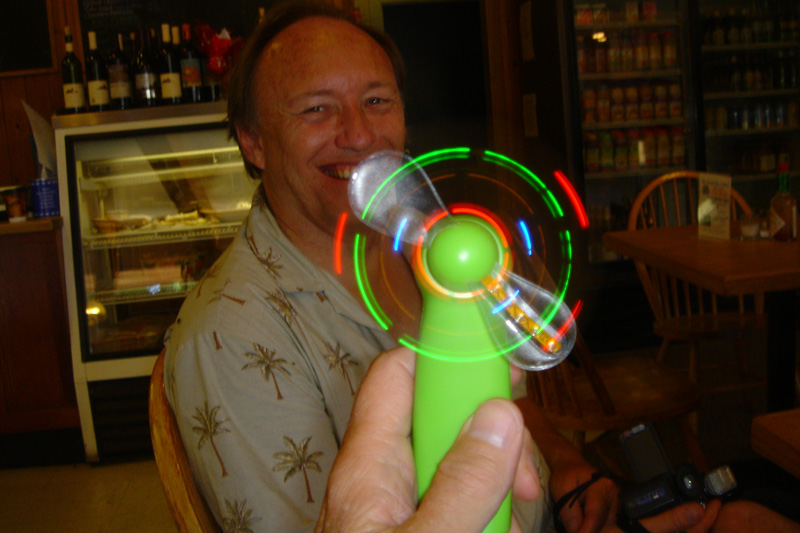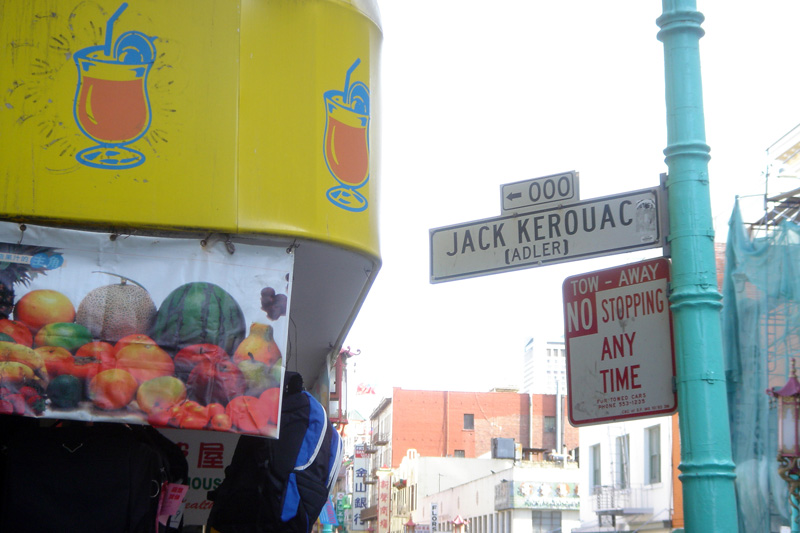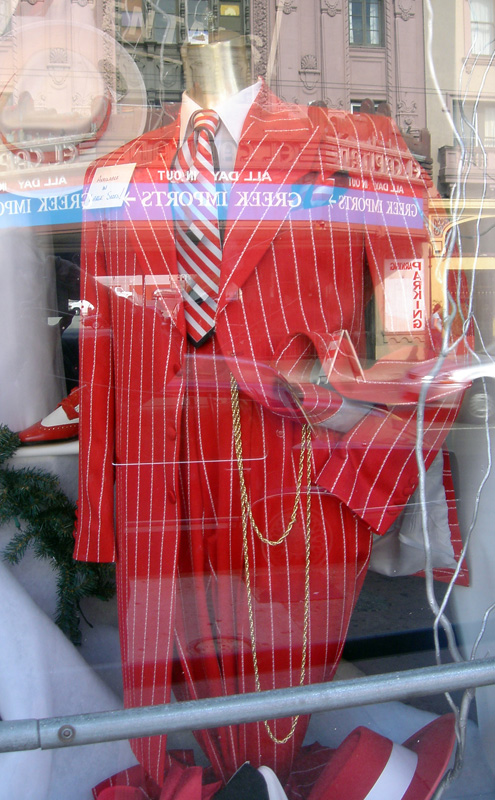
Mystery Customer
by Kris Saknussem

Ruger reported to the administrative offices of IMAGINE-NATION, a massive white building of Stealthfoam™ and Perspex, which appeared from the parking lot to adopt the curved shape of a giant paper nautilus shell. Nearby two holograms forty feet high, dressed in kendo uniforms, conducted their stylized combat in perfect silent detail, while on top of the building at random intervals a Pony Express rider would gallop into view and rear up on the back of a zebra, becoming the somber noble face of Nelson Mandela or the coy smile of Betty Boop—the images fading into each other like the daydreams of some immense technological entity running a fever.
In the main lobby Ruger was greeted by an eidolon butler with a radiant white carnation in his buttonhole. The butler promptly morphed into a bikini-clad blonde and then into an old-fashioned town-crier and led him down a hall ringing his bell—the noise seeming to come from a sound system embedded in the walls. The town crier led him to the Human Resources Department, morphed back into the bikini-clad blonde, and disappeared with a giggle.
The reception desk in HR was manned by a black woman in a magenta turtleneck. She gave Ruger a blank look and told him that Ms. Bertram would see him shortly. Behind the receptionist’s desk was a virtual conference facility where virtual boardroom presentations were made and virtual training programs were conducted—and in an open plan area off to the right, he noticed several vid-phone monitors were actively redirecting calls. On the wall over one of the empty desks was a liquid crystal display panel that read THIS IS A PEOPLE BUSINESS. ARE YOU A PEOPLE PERSON?
When the black woman at the front desk finally said “Ms. Bertram will see you,” the walls which had partitioned her office from the reception area melted away and all he had to do was walk over to her desk—where he was surprised to see the same black woman again, but this time dressed in a black silk suit and wearing expensive jewellery. “Ms. Bertram” addressed him in a distinctly prim, nasal voice which was unmistakably that of a middle-aged Midwestern white woman. “I’m sorry I can’t be with you in person. I’m working from home today and conducting a virtual seminar in Rome—so I’m sort of all over the place.”
“That’s okay,” Ruger said, as the black woman seated in front of him moved her lips when the voice spoke.
“Now, first we need to derive a personality profile,” Ms. Bertram said. “What’s your favorite color?”
“Purple.”
“Now repeat after me...”
“Now repeat after me.”
“Very good.”
“Very good.”
“Enough. Now, listen, I’m going to say a word and you tell me the first word that comes into your head. Right?”
“Left.”
“No—”
“Yes.”
“I—”
“You.”
“Stop!”
“Go!”
“All right!”
“That’s actually two words.”
“Yes,” the white voice said, a little impatiently, as the black lips moved. “Now, I’m going to ask you a few general knowledge questions, okay?
“Sure.”
“What is the main symptom of Zollinger-Ellison syndrome?”
“Recurrent attacks of epigastric pain, nausea and vomiting.”
“Correct. What’s the fastest bird in the world?”
“The spine-tailed swift.”
“Excellent. Now, I want you to go in the other room and complete the questionnaire and then come back.”
One of the walls melted away and Ruger saw a table with an electronic formpad on it. Several questions appeared when he sat down.
•Have you ever blamed someone for something you did wrong?
•Have you ever taken pleasure in teasing an animal?
•Would you like other people being afraid of you?
•Do you enjoy seeing someone who has done wrong get punished?
•If you saw a real animal caught in a trap, would you set it free?
After he’d completed the questionnaire he stepped back to Ms. Bertram’s desk and the black mannequin reanimated, consulted his scores, and continued the interview, frequently mentioning something called “The Customer Interface.” Then she showed him a series of photograms and asked him which three people he would most want to work with. Ruger remembered from his days at the Clinic, that one of the diagnostic tests often foisted upon people suspected of mental illness was to show them pictures of people and to ask them which ones they would most want to have as fellow passengers on a trip. What the subject wasn’t told was that all of the people were mentally ill. The thinking behind this technique, called the Szondi Test, suggested that the subject would pick out people with similar problems.
Ruger flicked casually through the digipics and then said that he wouldn’t mind working with any of the people shown, and that only by meeting them and actually working with them for a while could he make an honest assessment of their character. The black woman’s face seemed to light up at that, and he got the feeling he’d answered well in Ms. Bertram’s eyes.
“Now,” her voice twanged, “Are you interested in Hygiene or Satisfaction? Promotions and Marketing—Essential Service Delivery? Security, Maintenance—Admin?”
Ruger paused. “Didn’t Mr. Fruge tell you? I want to be a Mystery Customer.”
The black woman’s face seemed to glass over for a moment. “Oh,” said Ms. Bertram apologetically. “I thought you were seeking an executive position. I’m sorry to have put you through all this.”
“That’s all right,” Ruger shrugged. As it turned out he’d been taking the A-level profile assessment. The C-level testing procedure, which is what he was supposed to be undergoing, was aimed at “non-management” general working staff and focused on topics like Financial Modeling, Strategic Planning, Integrated Marketing, Employee Relations and Stakeholder Delivery. Fortunately, because Ms. Bertram was due at another virtual conference in Toronto and nursing her cloned cat through an in-grown whisker crisis, she dispatched him directly to The Induction Center to meet “The Welcomer.”

The bikini-clad blonde faded back in, this time wearing the butler’s suit, and told Ruger to follow her—which he did, despite the fact that in place of the white carnation in her buttonhole, out poked the miniature head of the town crier.
The Induction Center proved to be another completely empty room, but projected on the walls was an ever changing series of images of happy customers and staff, holograms of customer service and tourism industry awards, celebrity thank-you letters and profiles of various terminally ill children who’d been granted their dying wish and turned into animatronic characters throughout the vast theme park. In and around these floating images, in big bright colored letters, liquid crystal signs flashed phrases like EVERY DAY IS TODAY...FUN IS OUR BUSINESS...WORK IS PLAY...REALITY IS FOR DREAMERS...NOTHING IS MORE VALUABLE THAN A SATISFIED CUSTOMER...THERE CAN BE NO US WITHOUT THEM...
Out of this montage of customer commitment and esprit de corps, The Welcomer emerged—a hologram but with such a meaty three-dimensionality he—or rather “it” appeared to be an organatron. Ruger thought the rotund outward form was that of the opera singer Luciano Pavarotti, but The Welcomer’s image was in fact based on Sebastian Cabot, a long-dead television actor who’d once played “Mr. French” on a forgettable mid-20th Century comedy called Family Affair. Somewhat incongruously, the figure was dressed in the shorts and sweatshirt uniform of a summer camp counselor—and for politically correct, social demographic and psychological response reasons—it spoke with a synthetic voice based on the old film actress and former U.S Senator, Susan Sarandon. The effect was odd—but no more so than watching as the still faces of staff which kept appearing and dissolving on the walls would suddenly animate and welcome Ruger to the team. He wondered for a moment if there was going to be some sort of ceremony to finalize his introduction, like a baptism or the taking of communion—but then he realized this would be unnecessary. From the moment he’d walked into the room, or the room had come to meet him, he sensed some powerful hypnotic process at work.
The Welcomer presented him with his briefing kit: a homeopathic learning module, subcutaneous identification password, laser parking permit, and mimeographed and stapled employee benefits package. Then the Welcomer outlined his probationary training assignment in VictorianLand. Employees could only access information about the specific area they were working in at the time. “Everything here is handled on a Need to Know basis,” The Welcomer smiled. “This way staff stay fresh and focused and it’s more fun for everyone.”
But what seemed even more remarkable was that every area of the park also had a simulated version of itself where training was conducted.
“You mean I won’t really be working in VictorianLand. It’s actually VictorianLand-Land?” Ruger asked.
“IMAGINE-NATION has the most rigorous and effective training system in the world today,” The Welcomer smiled. “The simulated training program will put you through a complete, detailed introduction to interacting with the park, your character or range of characters, and most importantly of course, our customers.”
“But the customers aren’t real.”
“Well, of course not,” The Welcomer smiled. “How can you be expected to perform according to standard with real customers without undergoing proper training? And how could the park in good faith inflict untrained staff on the public?”
“So, this is just a training program. You pass and then you move on to the real thing?”
“In most cases,” The Welcomer smiled. “But many people find they’re not suited to working with real customers and so they stay on as simulated customers in the training areas.”
“You mean they’re Mystery Customers?”
“No, no,” The Welcomer smiled. “A Mystery Customer is someone who appears to be a real customer in the main park areas in order to secretly assess levels of service, efficiency and professionalism. Simulated customers in the training areas aren’t pretending to be customers, they actually are customers—hired by IMAGINE-NATION. Understand?”
“I—I think so,” Ruger said. “So, there’s Simulated Customers and Mystery Customers...”
“Well,” smiled The Welcomer. “We don’t use those terms. The so-called ‘simulated customers’ are officially called Service Testing Agents and are informally referred to as ‘mirrors.’ What you call Mystery Customers we term Assessors, although you’ll hear them called ‘shadows.’ Then there’s the Intelligence Unit, under the control of Konrad Kriegsspiel, the Director of Security—who have their own staff which oversee the performance of all other staff. Their agents are known as Familiars and their brief includes posing as staff to check out other members of staff, as well as assisting staff by impersonating customers.”
“There’s a lot to customer service, isn’t there?” Ruger said.
“Oh, my yes,” The Welcomer smiled.
Ruger spent the next week at home in his little apartment participating in a virtual training program with other virtual new employees, which created the illusion of being back in the IMAGINE-NATION offices without having to fight the Solarcycles, burros and endless paramecium movement of cars. He then went to CustomerLand for a two-week intensive training program which he passed with flying colors.

His first assignment was VictorianLand, which had started off as the place to savor the romance of gas jets, electricity experiments, mesmerism and ballooning. Progressively it had concentrated more on the Dickensian underbelly of London—namely the festering, writhing, squalid dens of thieves and screevers, magsmen, whores and hunchbacks. The sophisticated ventilation system pumped out the rich odors of coffin ships and pig boats while a special mouthwash gave the fishwives and the prostitute characters breath like toasted herring. You could hobnob with costermongers, skulking street arabs and urchins of all descriptions. Cauliflowered-ear prizefighters would leer at you from the doorways of gin palaces—or try to drag you in to some exciting attraction like badger baiting—while in the “opium” dens, dream-like shadows moved, stirring up the stinking air.
Hear the colorful street cries of sellers of hare and kidney pies! liquidplexposters at the ticket consoles promised. Thrill to the authentic charm of imbeciles and cripples ringing bells!
Everything was a precise replica—from the rosewood-framed mirrors to the hot grog served in the music halls. All the “actors” had been specially trained in such skills as fat-boiling, fell mongering, glue rendering, tripe scraping and dog skinning. Strolling down the manure-laden cobblestone lanes, watching a gang of ruffians bludgeon a legless organ-grinder, Ruger was disgusted and impressed.
His probationary training assignment officially installed him in the simulated version of VictorianLand, which meant that the so-called “guests” were in fact fellow employees. But what he found particularly puzzling was that one of the tactics the training sessions alluded to was the undisclosed integration of the simulated version with the authentic version so that all employees would stay at peak form. He thus was actually unsure where he was working—or with whom. He was given a cover story—two in fact, one for his London 19th Century persona (to give to real customers)—the other for his “real” self, should conversations start up with other staff (in case their real job was as a Familiar). Employees were encouraged to contribute to the latter, on the premise that the more they believed in what they said, the more convincing they’d be. Ruger posed first as a Bone Grubber and then a Blind Beggar, and over a month came to know the Baked Potato Man, who was a woman named Bonny, a struggling student—and Old Sarah the Hurdy-Gurdy Player who was also a woman but who’d once been a man named Brian, who’d started out his career in show business as one of the Hefty Harpooners at the Burbank Angling Club. “How ironic,” he told Ruger. “To have been born a woman trapped in a well-hung man’s body.”
Another acquaintance was The Fantoccini Man, the master of a horse-drawn carriage that housed a marionette theater, featuring a hornpipe-dancing sailor and a Scottish lass doing the Highland Fling. The Fantoccini Man was supposed to be a chubby Italian named Giuseppe, but was actually a recovering alcoholic named Jim Fletcher who wore a fat suit and who’d once been the Senior Animator on the Wilde and Woolly Fun Hour. Of course, all of these stories might have been fabricated—or they might’ve been as true as Ruger ’s, for he told them he was a cultural historian, working undercover to document the disintegration of civilization and the emergence of the new post-biological culture.
The whole operation—from the slogans like THERE CAN BE NO US WITHOUT THEM and FAMILIARITY BREEDS ALIENATION—to the distinct feeling of always being watched—was difficult to get used to. And yet, as the weeks went on, Ruger became more relaxed. He began to settle into his character of Blind Beggar, watching secretly as the carefully contrived streetlife unfolded. He grew familiar with the mudlarks and the river pirates and the rag and bottle merchants. He even developed a taste for hot eels and fried brains. And over the weeks he came to see that on the surface things seemed to move with a digital precision—for instance the frightening Run-Away Carriage or the Hilarious Row Between the Fat Tart and the One-Armed Birdseller—but in fact this careful choreography masked another life that carried on chaotically just below the surface. It was this life that interested him most. He kept his blind eyes open.

One day, one of the chimneysweep boys was discovered caught inside a smokestack rising from an old brick kiln. Ruger happened to be right there, so before any of the park’s elaborate and secret security forces could respond, he went to the sweep’s aid.
The kiln resembled a giant beehive oven and up inside the dark pillar of the chimney, the terrified boy panted and squirmed, scraping skin against the mortared brick. The inside of the passage was double-brick, and a portion of the lining had crumbled away, leaving enough of a hole for the chimneysweep to twist a leg in, so that it could no longer be removed by pulling upward. Ruger felt his way up into the narrow passage—until he was able to touch the boy’s bare leg, which was comforting enough to stop the kid crying. Then over the course of many dark, breathless minutes, he was able to calm the boy and feel how the leg was trapped. Reasoning that the smokestack was too high to climb out of, Ruger realized that the only way to extricate the prisoner was to slowly turn him around, like a breech birth, until at last he could slide out head first.
By that time, other people had appeared—a pieman, a flower girl, a constable, a society woman, a bawd—and a man with a wooden leg and a spider monkey on his shoulder. They all watched and kibitzed while Ruger blindly worked.
“Blimey,” said a Rat Catcher coming upon the scene several minutes later. “Old Blinks has saved the lad!”
And it was true. The sweep had been gradually turned inside the smokestack until his sprained ankle had finally popped free. Then, cradling him one-armed as he slid down the rough wall, tearing at his clothes until he felt raw skin, Ruger was able to draw the boy out the heavy kiln door into the light—to the cheers of the crowd. Perhaps most remarkably of all, he’d delivered the sweep from the crippling confines of the stack without ever stepping out of character as a Blind Beggar, for he’d found the boy by sound and feel.
When the chimneysweep had been dragged through the door of the oven and was getting his breath back—and they were both brushing the masonry dust from their perfectly replicated rags, Ruger spotted a syringe on the floor and realized what it was that had tempted the boy up into such a strange and dangerous spot. Quickly he pretended to stumble to the floor, so that he could snatch the hypo so no one else would see.

The next thing he knew he was lying, still in his Blind Beggar costume, in some sort of hospital, which he realized was one of VictorianLand’s infirmaries—this one hidden inside an asylum. There were all sorts of lunatics and idiots—crazed people imagining they were Jesus—or beadles and train conductors—clamoring and gibbering. Fortunately a nurse came, or a woman dressed like a nurse, and led him out of the ward into a quiet chamber where sunlight streamed down through an iron-barred window.
There was an elegant but very simple grandfather clock in the room, housed in a cherrywood case with a glass door with bevelled edges. Out of this door there emerged a hologram of the Welcomer, who grew to full size when he’d stepped free of the clock. He was dressed as an English bobby now, and instead of speaking with the voice of Susan Sarandon, his speech was deep and understanding like the late great Anthony Hopkins after a couple of nips.
“That was fine work,” he said.
“T-thanks,” Ruger replied. “Is—the boy all right?”
“He’s not a boy. He’s actually an organatron,” said the Welcomer. “One of the more sophisticated new models. But you wouldn’t have known that. They’re very clever, our technicians.”
Ruger let out an exclamation he wished he’d kept to himself.
“Surprised he has a substance abuse problem?” smiled the Welcomer, and handed Ruger the syringe he’d tried to hide. “One of the new nerve agents. It’s called Seduction. Very addictive they say. Delightful beyond words.”
“But—”
“It seems that some of the organatrons have picked up some bad habits from—how shall I put it? You others. Sensual pleasures, strange delusions.”
“So the boy—”
“He’s been Modified,” the Welcomer smiled. “Despite the dangers of unplanned personal initiative, the Familiar on the spot gave you a high score.”
“The man with the monkey,” Ruger said.
“I’m not at liberty to reveal that. Besides, I don’t know.”
Ruger swung his arm through the image of the fat bobby—with no effect. “So what now?” he asked.
“You’re going to receive a commendation—at least I hope you’re going to receive a commendation. In any case, the Director of Security wants to see you, so it will either be good news or bad. Perhaps you’ll be asked to provide some helpful information. Remember, it’s so helpful when you provide helpful information. You’ll find a hansom cab is waiting outside to take you.”
With that, the Welcomer tipped his helmet and stepped through a painting on a wall. The ornately framed oil showed a country squire posed with his hounds. Ruger waited a moment, then straightened the painting, stuck the syringe square into the squire’s head and walked out of the asylum past all the raving inmates, many of whom looked like they were quite enjoying themselves.
Whether the chimneysweep was a boy or one of their new machine-creatures, he vowed he wasn’t going to say a word or agree to do any more spying than he already was. Employees have to stick together. Weird drugs or no. Besides, who knew where those drugs came from? Every day is today, he thought. There can no us without them.
---End---
About the Author

Kris Saknussem is the author of the wild literary SF novel Zanesville. He grew up in the San Francisco Bay Area but has for a long time lived abroad, in the Pacific Islands and Australia. A painter and sculptor as well as a writer, his fiction and poetry have appeared in such publications as The Hudson Review, The Boston Review, The Antioch Review, New Letters and ZYZZYVA.